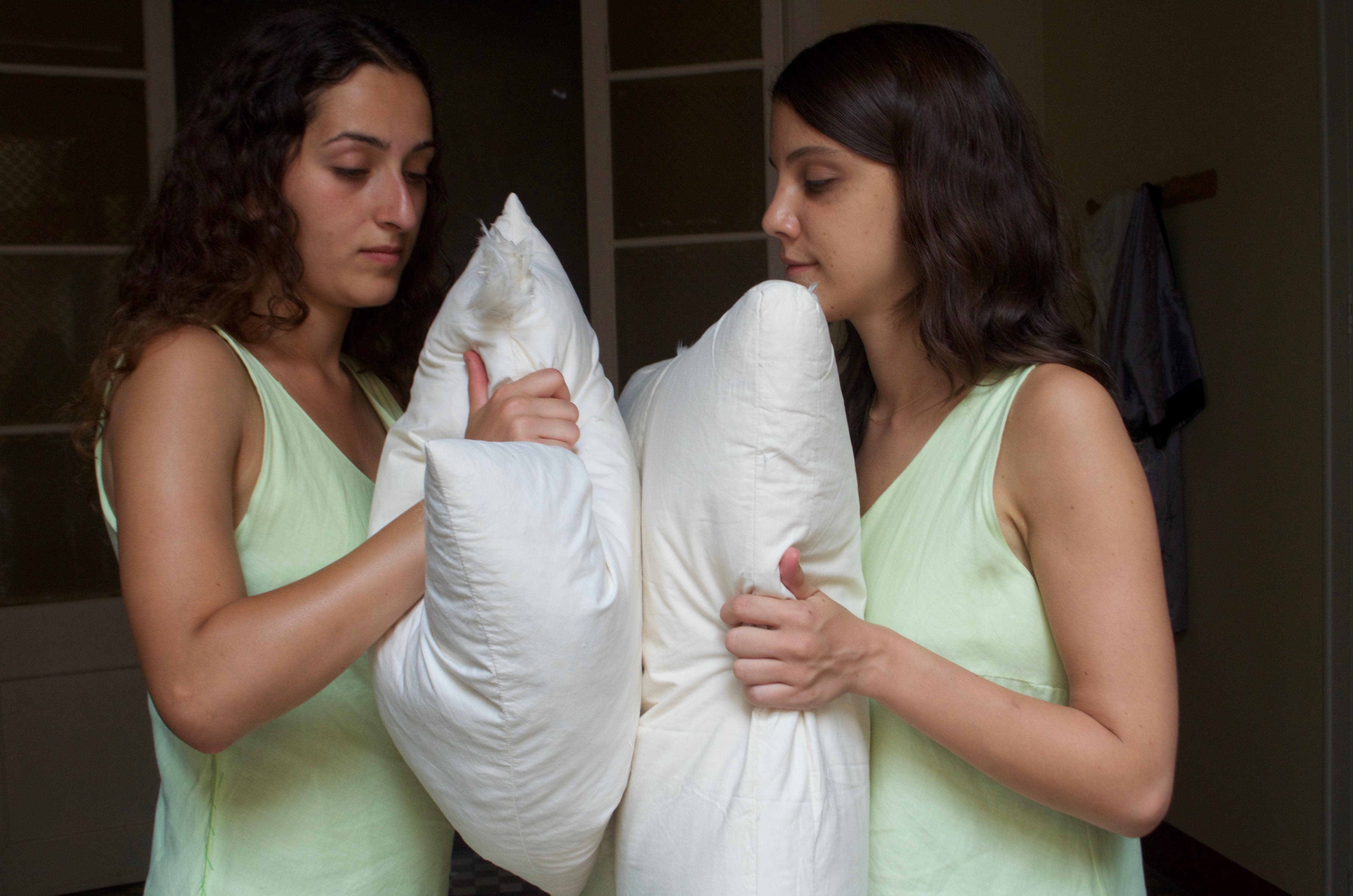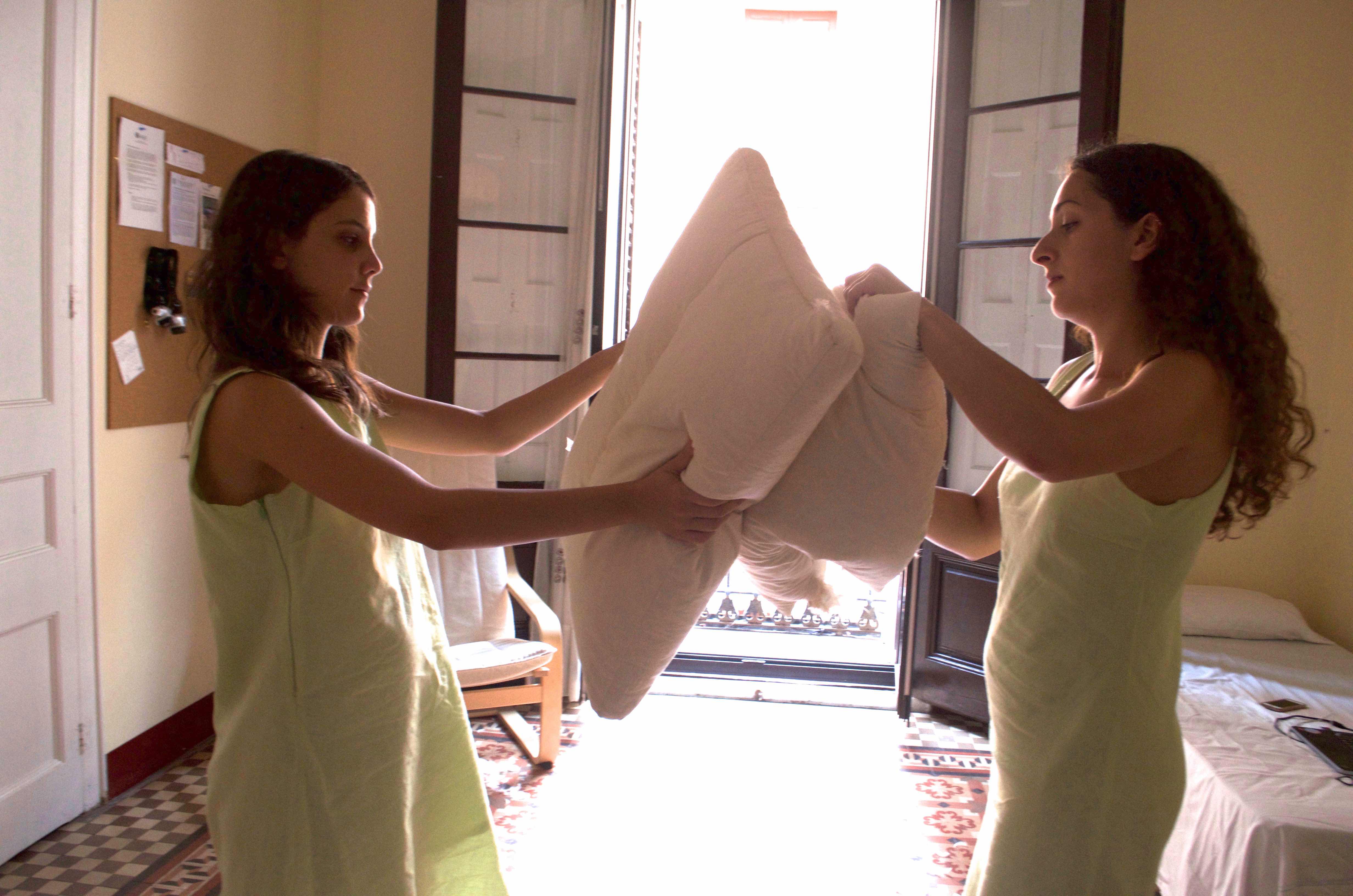Anne Murray met the duo, and they discussed their performance and video work, featured at the exhibition “Open House”, curated by Mimar Ceki Duşi.
The video you presented at the Istanbul Biennial combines different perspectives; for example, you have added frames within frames — what is the goal of the clips overlapping the overall scene? What role does sound play in this video?
In a way, Jiwar is a story giving insight into someone’s domestic life. The struggles everyone faces, the friction between relationships, the repetition of it and the way everyone gets around it. The different frames reflect the different perspectives that someone could use to interpret a situation. When close-up frames are shown, sound can be heard clearly, but when visitors see the whole frame, they hear sound from the streets, and the action blurs with the outside world. Does your neighbor know of your struggles? Even if we hit the walls, they don’t have ears. Do you know of your neighbor’s struggles? At the same time Jiwar brings up the theme of privacy, the privacy that lies within people’s domestic lives, and the ways it is invaded. The fact that we are presenting the video through TVs installed in a domestic environment is enforcing the conversations around privacy and related subjects, from the media to surveillance.
What would you say about the immediacy of live performance, versus the video version of your work?
The performance itself is personal, it wasn’t planned or structured, it was about our own domesticity, our relationship, the friction and harmony between us and the ways we get around it. The video-installation piece starts from our performance and goes on to portray the bigger picture.
How do rhythm, repeated sounds, timing and movement play out in your performances?
Each performance differs in rhythm depending on whether it is choreographed or preset and if we are using sound or not. If the performance is spontaneous the rhythm feeds from our actions and the vice versa. Our chosen actions are either a reference or a representation of the way we portray our world and society, and other times our actions might be aimless and trivial, on purpose.

© Anne Murray
In previous works, one of you used a megaphone to direct the other, as in a march or choreographed dance. Is this related to anything in particular, the military, for example?
Yes, those performances could refer to the military, but also other power relations. We represent the minorities, but the authorities too, we represent the conscious and the unconscious, the artist and the art industry, a person under the patriarchy.
The megaphone is one of the many recurring objects in your work; why do you use it and why does it not appear in Jiwar?
The megaphone is, once again, the mimicking and embodiment of power relations. Elsewhere, the megaphone can also be a symbol of sovereign forces and revolution, empowering female voices within art communities. You could say that the megaphone is, in a way, representing the urgency of what we stand for. Jiwar instead represents personal barriers and maps within intimate territories, therefore we wanted to use the natural sound of our rhythm, bodily actions and the neighborhood.
What function do outside objects serve in your performances?
Objects are the main elements defining our actions. Each and every object has a different meaning according to the context of the performance. For instance, the pillows at the Jiwar Artist Residency have been used for creating a strong noise that could interact with the neighborhood. The sound of the pillows reflects the silent voices that are hidden behind the walls, reflecting the barriers existing within the contemporary urbanized neighborhoods.

© Anne Murray
What influences you?
Experiencing migration, exchanging ideas and our common feminist perspectives were what inspired our collaboration at the start. Our nations, religions and societies would say that we are meant to be enemies. Our ideas, beliefs, habits and views state the opposite; therefore, we embrace the concept of our separation through our collaborative efforts. Collaboration is our greatest treasure and we use it as an internalized policy and a tool to sustain the meaning and legacy of our harmony. Panicattack is not only a visual tool to expresses artistic codes, but it is also a living space where weight and oppression turn into miracles. The struggle of being who we are with today’s sovereign commandments and the confusion of displaced policies, economies, genders and communities, has become the stimulus that stokes the engine of Panicattack. The profound questions we ask about social, ethical and political issues in the West and East, have estranged us from familiar perceptions and political labels that we have been given under patriarchal structures. Consequently, we interlock with each other as a protest of unity and solidarity within the warfare of opponent norms.
While reaching for integrity within alienated, dominant structures, we are also creating our own new life conditions; where we discover ways of belonging or not-belonging within different shapes of identity. We approach our gender as a fluid consistency, an essence that shifts within two opposite cultures, while intersecting sexual visual codes within stereotypical discourses. We observe and intake our surroundings and our viewer in order to find answers about our own mindset and internality. Correspondingly, we have performed in a variety of environments with different audiences in order to reach platforms outside the white walls of exhibition spaces. Even though we seek to find alternative zones, we still interpret the meaning of the white cube space and its conception of performance art between the artistic or non-artistic viewers. Namely, we approach the gallery space as a resource where we create our own meanings of staging, showing and settling of art and its interaction with the eye of the spectators.

© Anne Murray
Eventually, Panicattack looks out to states of barbarity and creates site-specific artistic propaganda by connecting and shaping communities. Curating several group shows, and building installations that juxtapose the body, sound and performative acts, drove us to leading many other artists. Our visual statement absorbs the multi and mass media resources and re-enacts these tools by decoding old artistic forms such as painting and sculpture in numerous tones. We want to continue to unite and extend the scale of creating fictional moments and absolute situations in order to act contemporary and institutionally within our artistic agenda.









